|
|||||
|
|
|
|
|
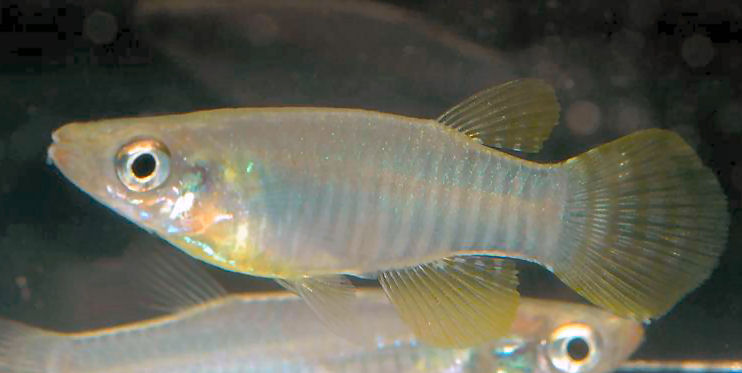
Zone Two
As one moves toward the north, the second zone contains the pluvial
rainforest of the Niger River delta. This region is characterized by a nine-month
rainy season, from March to November, with a rather dry August. This contrasts
areas further north where it only rains 4 months. Given the length of the rainy
season in the south, the temperature remains rather constant year round
and varies from the 21 to the 35 °C, but the average is 25-26°C. Water
conditions are characterized as: a pH of 4-6; conductivity is low 20-50 microSiemens
(DGH 1.5).
There are interesting killifish in this zone. These include: Fundulopanchax arnoldi, Fundulopanchax sjoestedti, Fundulopanchax gularis, Fundulopanchax filamentosus, Fundulopanchax powelli, Fundulopanchax spoorenbergi, (shownre spectively below) and others.
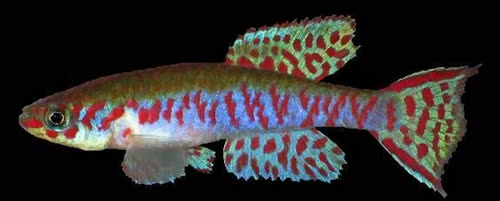

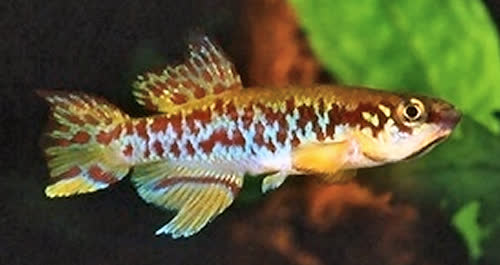

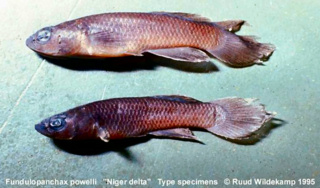

These species inhabit swamps, swampy areas of streams, or very slow moving
streams. All of these habitats are subject to partial (or a total) drying
out several times during the year. These fishes vary in size from about 5 to
15 cm.
All are bred in a similar manner. Because these are rather aggressive
species, it is recommended that you kept one male and several females of the larger
species in a tank at least 50-80 liters in size; while for the smaller
species smaller a 30 liter tank is probably sufficient. It is important to add
many hiding places as both males and females can kill the other. Create hiding
places by adding aquatic plants, fibrous peat moss, and/or spawning mops.
The hardness and pH of the aquarium water should be maintained at a medium
range values. Temperature over 25°C cause oxygen deprivation, so lower
temperatures are recommended. The aquarium should not be highly lit. While these
species prefer and do best on a diet of live foods (mosquito larvae, small fish
and earthworms), they can be adapted to others such as frozen and freeze-dried
fish foods. Partial changes (30% per week) are important in order to maintain
optimal water quality. Oodinium (Velvet) is a disease that occasionally
occurs
and can be difficult to cure.
To breed these species, you can set up a small tank (3-5 liters) that has
a 1-2
cm layer of peat moss on the bottom. The water should be fairly soft
(0.5-0.8
DGH). Keep the male and female(s) in separate tanks for several days to
condition them with quality live foods. At this time, after the water has
stabilized in the breeding tank, introduce the male with one female for
several
hours (2-8). After this time, it is advisable to again separate the pair
for
several days of conditioning. With 3-4 of these reproductive cycles, it
is
common to find a large number of eggs have been deposited (often over a
hundred). When the adults have been removed from the breeding tank,
collect the
peat moss, remove the excess water from the peat, and incubate in plastic
bags
for 4 to the 9 weeks (this depends on the species). When the eggs are
ready to
hatch, place the peat in a small container and add water with a
temperature of
15°C and medium hardness of one. Most eggs will hatch within a few hours.
As
an alternative, the eggs can be incubated in water, but normally many of
the
eggs will fungus and some of the fry may show defects. At birth the fry
are
able to consume baby brine shrimp. With frequent and regular water
changes, the
fry will reach sexual maturity anywhere from 6 weeks to 5 months,
depending upon
the species (faster sjoestedti and gulare, slower arnoldi - 2 months and
spoorenbergi - 5 months). The average life expectancy of these fish is
approximately 9 months for the fast maturing species, and one year or
longer for
the slower-maturing species.
Zone three
The third region is characterized by primary and secondary forest
containing
small streams, ponds and swamps derived from small water sources. Here we
find
Aphyosemion bitaeniatum, Aphyosemion callirium (whose area of distribution
extends from Togo into Cameroon), Aphyosemion bivittatum and Aphyosemion
scheeli which are shown respectively, below.
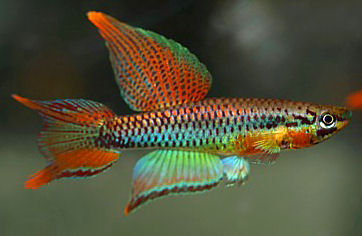

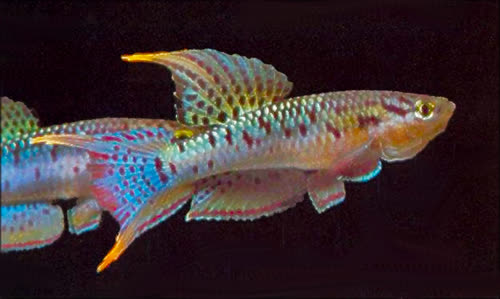
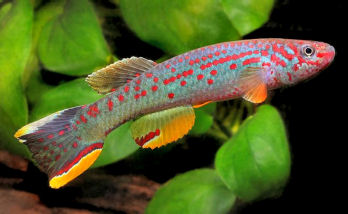
(whose dissemination is limited to the area northeast of the Niger River delta). These biotopes are characterized by the presence of usually permanent waters that are soft and slightly acidic; the color of the water varies from very opaque during the dry season to very yellow (amber) during the rainy season. The yellow color is due to the decomposition of great amounts of dead leaves that wash into the waters.
The males of the killies found in this zone are rather territorial and you will find one male approximately every meter as you move along the stream. The females move into the territory of a male when they are ready to spawn. In a small pool or pond environment, one tends to find the killies in breeding groups made up of several males, of which one is dominant, females, and juveniles. Killies feed upon terrestrial insects (mainly ants), the aquatic larvae of insects, and crustaceans. These fish tend to be rather easy to raise. They will lay their eggs on mops of synthetic wool or in peat moss. Breeding can achieved using tanks as small as 10-20 liters, because, usually these fish are not aggressive. It is, however, recommended that you add shelters for the females. These can be dense plant growths of Microsorium (Java Moss) and Vescicularia (Java Sword or Fern). These killies will deposit their eggs throughout a spawning mop, as well as in the peat moss. It is recommended that the eggs be collected and then incubated in small containers. The water in the incubation container should be similar to that of the parents, except fresh and clean. For the more difficult species, adding a disinfectant such as acriflavine or methylene blue can be helpful. Incubation averages about 15 days at a temperature of 24°C. It is important to monitor the eggs. Remove any that fungus (turn white and then appear fuzzy) and change part of the water regularly. Another breeding technique is to leave the eggs to develop in the tank with the adults. As the fry hatch, they tend to hide in floating plants near the surface where they can be scooped out and moved to a rearing container. For their first food, infusoria is necessary for the smallest fry and then baby brine shrimp. The adults will accept practically all live foods (fruit flies, mosquito larvae, daphnia, and also baby brine shrimp. When these are unavailable, these killies will adapt to frozen foods.
In the same biotopes as the Aphyosemion species, you will often find Lampeyes like Procatopus aberrans, Procatopus similis, Foerschichthys flavipinnis and Aplocheilicthys macrophthalmus.
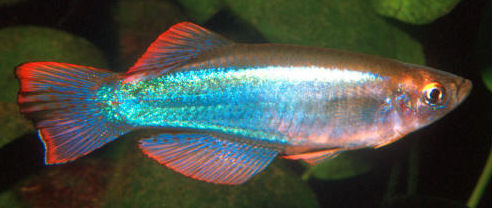
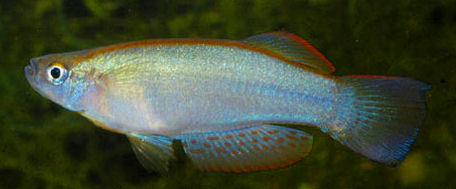
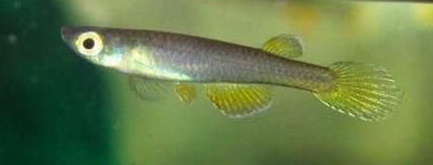
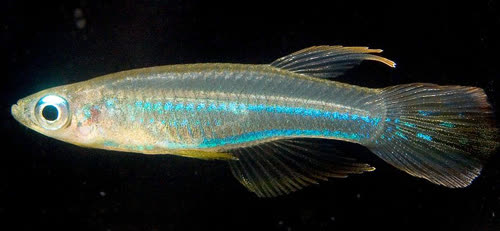
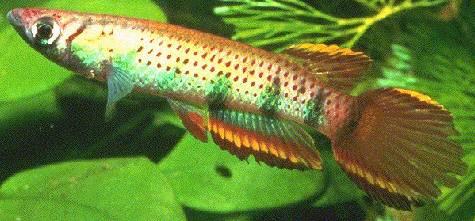
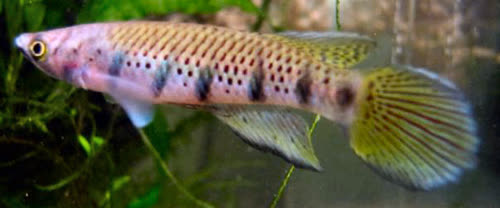
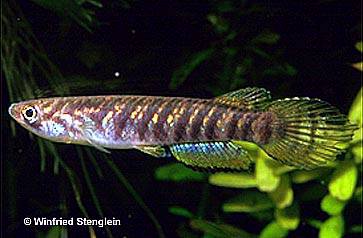
Zone Four
Practically unique to Nigeria (particularly in the zone north of the Niger
river
where the landscape is characterized as a savanna) we find the
Fundulopanchax
gardneri nigerianus. The more northernly populations have a marked
tendency
toward 'annual' reproduction. Many of their eggs enter into diapause
(arrested
development) and their incubation may require several months storage on
damp
peat moss. In contrast, the populations of Fundulopanchax gardneri
further to
the south, where the climate is much more humid, incubate in water and
hatch
after single 2-3 weeks.
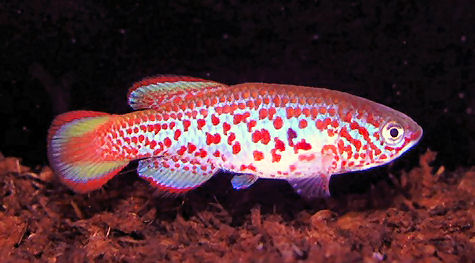
Another killifish that is found in the northeastern savanna is Nothobranchius (Pronothobranchius) kiyawensis (total length: approximately 25 mm). This is an annual species that can be maintained in tanks of 10-20 liters. The breeders lay their eggs synthetic wool mops or peat moss and those eggs require approximately a 3-month incubation in damp peat moss (identical to the procedures used with other Nothobranchius species).
As noted, the variety of biotopes is enormous. We can only wait for the political situation to stabilize before we can carry out searches for even more new species.